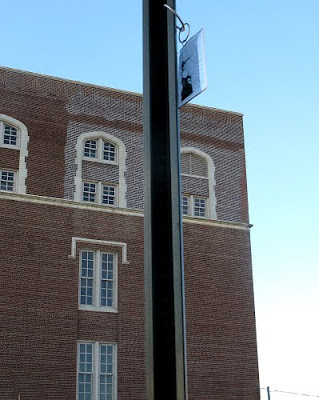













I did not visit the house that is supposed to be Lady Moody's, mostly because I forgot to go there. I was so taken with finding the original outline of the settlement and its center. There is an old house on Gravesend Neck road just over from the subway station, which is where Deborah Moody may or may not have lived. It is very old. The rest of Gravesend has certainly changed, but I think it kept some of original energy.
Tuesday, September 29, 2009
Visitation - Deborah Moody: Part II
Wednesday, September 23, 2009
Visitation - Deborah Moody (1586-1689): Part I
I discovered Lady Deborah Moody while I was searching for something else. She is the only woman to found a colony what is now the United States. As a widow in her forties, she left England America because of her religious beliefs. Arriving in the Massachusetts Bay colony, she hoped to find refuge. Although the townspeople were pleased to have a noblewoman living in their midst, there was soon tension between her and the town elders because of her independent ideas. Deborah Moody believed that baptism should be reserved for adults. She felt that it was an assault on an infant's free will and should be reserved for believing adults. Anabaptists were severely persecuted in Europe where it was considered heresy. It seems that Lady Moody was chagrined to find the narrow minded spirit of the people of Salem. The elders were somewhat shocked to meet a woman who had not only read the scriptures but could debate them about their meaning.
She left Salem before she was banished. She led a group of dissenters to the colony of New Netherland and was granted land in Long Island. Although the Dutch were not fond of Anabaptists, they allowed Lady Moody and her group religious freedom. She named her colony Gravesend after the place in England where she lived with her family.
 The town was divided into four quadrants which were subdivided into ten plots and was protected by a 20-foot high palisade. Outside of town were triangular farms known as boweries that radiated out from the wall looking like the spokes from a wheel. In the center of town was the Town Hall. Attendance at monthly meetings was required. The town leaders were elected democratically. Because Lady Moody held substantial real estate (including Coney Island, Bensonhurst and Sheepshead Bay), she had the right to vote, the first woman in the colonies with this right. She had a profound commitment to religious tolerance. Many groups shunned by other colonies took refuge in Gravesend. The first Quaker meeting in the colonies was held in her house.
The town was divided into four quadrants which were subdivided into ten plots and was protected by a 20-foot high palisade. Outside of town were triangular farms known as boweries that radiated out from the wall looking like the spokes from a wheel. In the center of town was the Town Hall. Attendance at monthly meetings was required. The town leaders were elected democratically. Because Lady Moody held substantial real estate (including Coney Island, Bensonhurst and Sheepshead Bay), she had the right to vote, the first woman in the colonies with this right. She had a profound commitment to religious tolerance. Many groups shunned by other colonies took refuge in Gravesend. The first Quaker meeting in the colonies was held in her house.
She had a little trouble calming down the local Indians. There was a nasty fight where she had to call in help from the Dutch. She finally bought them off with some pelts and trinkets. She pretty much lived happily ever after. She was buried in the Gravesend cemetery under an unmarked grave. There is an old house in Gravesend which is supposed to be where she lived, but there is no real proof. The deepest trace of her passage is the outline of her village which is still present in Brooklyn, skewing the street grid.
The impression I got from everything I read was that Deborah Moody was a very intelligent woman who was honest and clear in her beliefs and unafraid to speak her mind. She suffered a great deal because of her outspokenness. The deputy governer of Salem wrote in warning to the governor of New Amsterdam, "She is a dangerous woman." She also gathered a group of devout followers and many people respected her and sought her counsel including Peter Stuyvesant. The men of her family were educated at Oxford, it seems clear that the women were at least taught to read, write and reason. She lived during a time of great turmoil. The reform movement brought about many new ideas, I think Deborah Moody lived in a privileged and enlightened world. She had a strong influence on her fellows which has filtered down to us.
Cool Links:
Gravesend on Wikipedia - scroll down to early history to click on map showing outline of Gravesend on a Google map of Brooklyn.
Lady Moody on History of Women Blog - Nice summary of her story
A Dangerous Woman: New York's First Lady Liberty:
The Life and Times of Lady Deborah Moody
by Victor Cooper - some awesome exerpts from this book on Google books which gives a unique perspective on the thinking of Deborah Moody. (I know, I should have bought and read the whole book, not just parts. It seems to be very well written and offers much to ponder.
I will post the pictures from the street art installation in Gravesend soon.
Tuesday, September 15, 2009
Rude Return
The weather last week erased any doubt that summer was over. It was miserable and rainy, threatening to be cold and then just getting humid and oppressive.



The rainy weather has been punctuated by brief visits from the sun. The light is always the most beautiful just before the sun slips behind the clouds.







